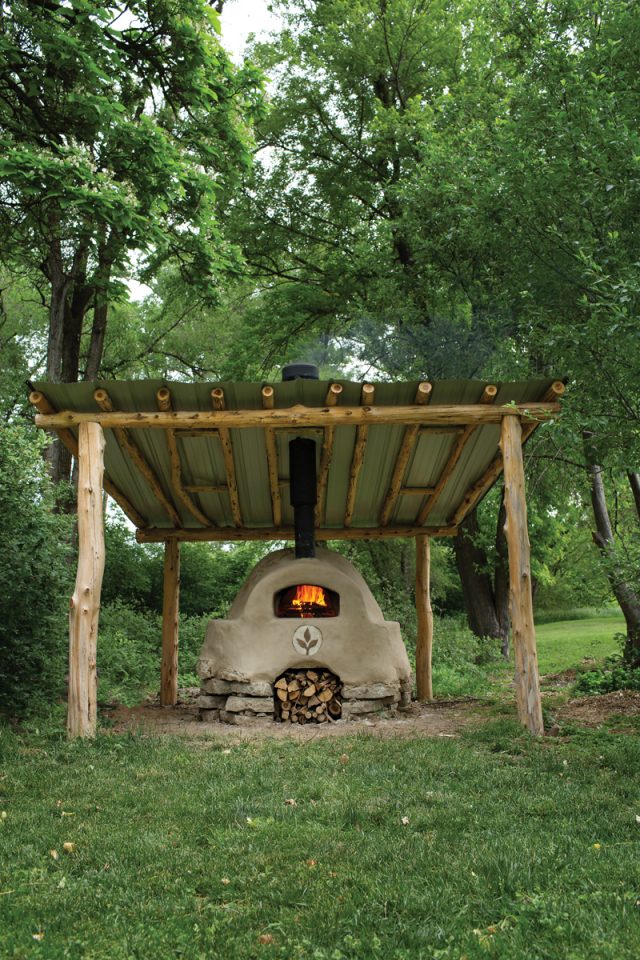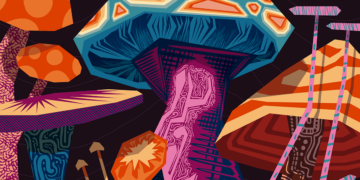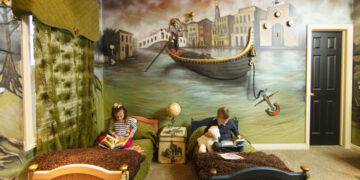The day I met Jim Schalles he was busy with a machete. That spring afternoon, we found ourselves in the far corner of City Sprouts’ half-acre lot on the corner of 40th and Franklin streets in near-north Omaha. Schalles’ goal for the day was to prepare the lumber that, once dry, would frame a small roof sheltering an earthen oven he’d been commissioned to build for the community garden. As we talked, Schalles and the machete stripped long ribbons of bark from the pile of freshly cut eastern red cedar stacked beside him. Cleaning a full trunk down to its smooth blonde core, he would hoist the thing with considerable ease over his head, toss it out of the way, and begin again with a new log. His dog, Adobe, curled asleep in a nest of mulch beside him, was little impressed.
Schalles is an Omaha native who grew up in the oak and cottonwood forests of Ponca Hills north of town. Until recently, though, he’d been passing time in southern Oregon, immersing himself in a rather broad range of disciplines in pursuit of his permaculture design certificate with the Aprovecho Sustainability Education Center. Coursework there included roundwood timber framing, earthen concretes, and clay-based stucco construction. “I left feeling like I could certainly build a house,” Schalles says.
Permaculture design, at its roots, is guided by the patterns and forms observed in nature. Rather than engineering structures, agriculture systems, and societies in opposition to the natural world, the movement seeks to embody a thoughtful reflection of nonhuman systems and the inherent design wisdom found there.
While it’s hard to imagine a better environment for a natural builder to cut his teeth than the dewy old-growth forests of Oregon, Schalles found himself drawn back to the hills and scrubby oak forests of his youth.
“I really missed the climate and culture and people back here,” he reflects. “If I’d grown up in the Northwest I probably wouldn’t have left. Clean swimming holes and mountains and redwoods and beaches, all that great stuff. But when I was hiking around the redwoods I never really felt at peace. I was almost on edge with awe. There are these giant trees that you’re astounded and kind of bewildered by, but it’s different from the sense of security and peace that I feel walking around these giant cottonwoods and the oak savannah that I grew up in.”
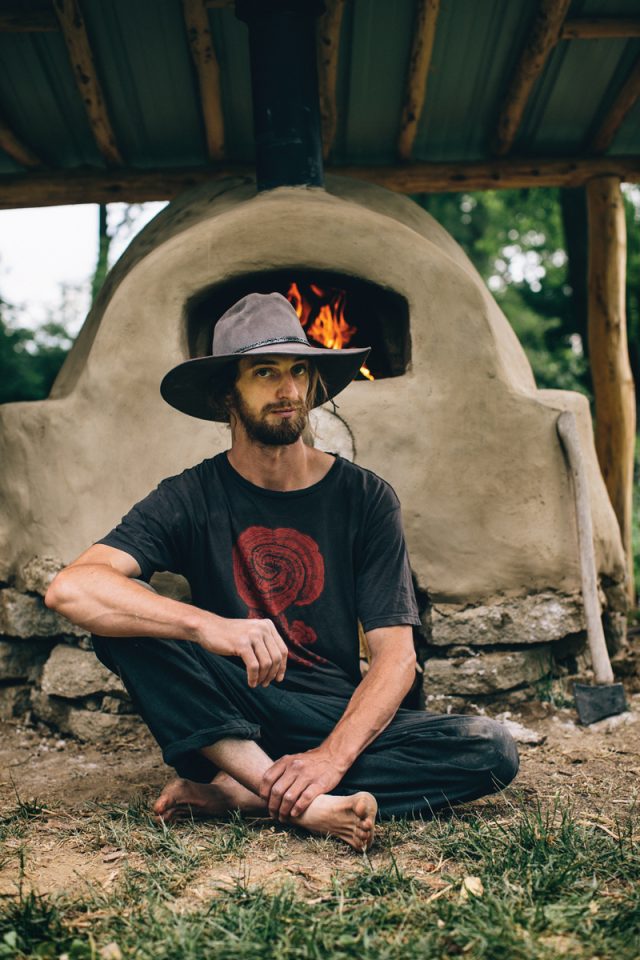
Reacquainting himself with the rhythms of his native landscape, Schalles recognized an opportunity to provide a service that was currently unavailable in the area. From this, Tallgrass Vernacular was born, a full-service construction and design business which serves to bring the principles, ethos, and aesthetic of natural building back to the Missouri River Valley.
The name, Tallgrass Vernacular, references the vernacular architecture style, which Schalles describes as “building with things from the locality in which the building is being created. It embodies the nature of the area where you build. If I’m building in the Loess Hills, for example, I like mimicking the geography, the rolling hills with steep edges, so the structure not only is built with the things from the area, but it also embodies the essence and the culture and spirit of the place as well.”
The community oven at City Sprouts exemplifies this precept down to its foundation: an assemblage of broken sidewalk concrete sourced from only a few hundred feet away. The subsoil clay integrated to the concrete was also pulled right from the neighborhood.
While such a construction may sound renegade, Schalles is quick to note that his practice is firmly rooted in tradition and techniques that have stood the test of time. “As a builder, safety has to be a priority. If I want to make an argument for the value of these traditional practices, it has to come from within the guidelines of the building code. If we’re just building like hippies in our backyards and keeping it off the main radar, we’re not able to spread the real benefits of these techniques and make them more accessible. In some ways, I want to see the codes progress and be made more inclusive, but in the meantime I’m happy to learn them thoroughly and make sure I’m building things in accordance with the law.”
To watch Schalles at work is to see a person very much in their element. With a casual diligence, he appears fully comfortable with both his material and ability. There is, in fact, little to distinguish Jim Schalles’ professional life from his personal. Which is how he prefers it.
“I think living in conjunction with the seasons that are around you is really similar to the way that I build things or the way that I live my life in general. It’s all of us being on the rhythm of when’s the best time to plant our seeds—whether that’s the metaphorical seed of your idea or your literal can’t-let-the-frost-kill-your-vegetable seed.”
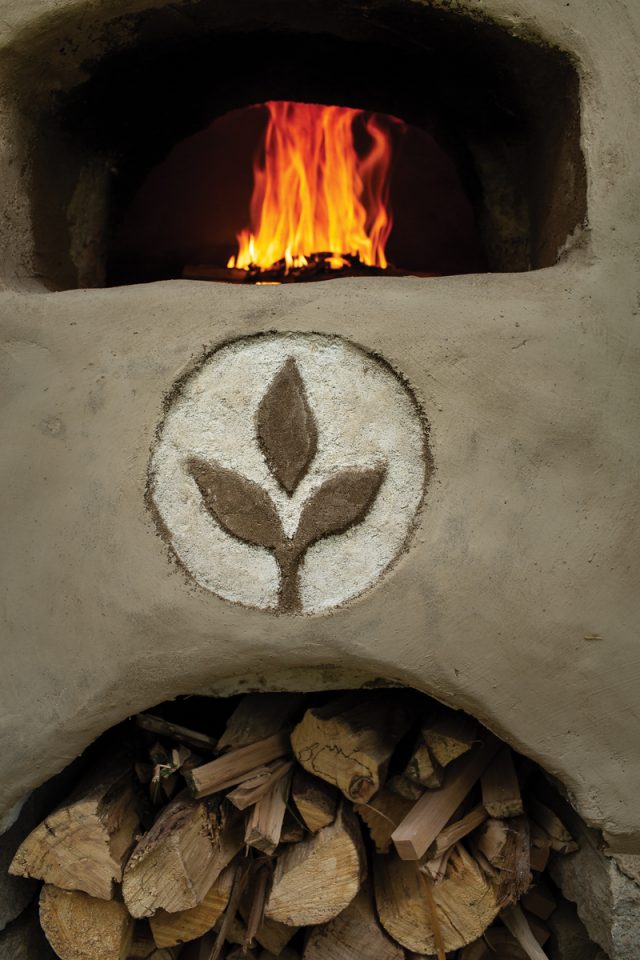
In fall 2016, a chance meeting in a Ponca Hills bar provided Schalles an opportunity to commit himself to honoring this rhythm of the seasons in a more substantial way.
Still fresh from his time in Oregon, Schalles found himself trading rounds with a retired local farmer in need of a hand. Today, in exchange for a few hours of farm labor each week, Schalles and his partner have been allowed to build a home for themselves on a segment of land nestled against the Loess Hills State Forest.
Of course, the Schalles home is no conventional affair. The main living quarters are an elevated yurt supported by reclaimed lumber and local cedar. The home is warmed by a wood-burning masonry heater, also designed by Schalles.
“To have this been the first winter I spent in the yurt, in something I built, in the Midwestern winter, was really cool. To know that we survived, but to look at it in hindsight now that we’re past the worst of the winter and wonder, okay how do we make this more habitable for next winter.”
It’s in hard-earned conditions like these that the seeds of utopia are sown. A solar shower, a wood-fired bathtub under the stars, a straw bale sauna—Schalles’ plans for the future are as ambitious as they are enviable.
“If you’re committed to keeping your costs low, you can afford to work a full-time job in your garden growing food,” he says. “And what more do you need? When you’ve got your shelter and food taken care of, your mind starts to go wild with these ideas.”
Like many great optimists, though, Schalles’ bright visions of the future are held against a vivid recognition of the dark places we now find ourselves in, culturally, ecologically, and architecturally.
“We’re in this crisis right now in the way that we build things. The bottom’s going to fall out sooner or later, and hopefully it’s not detrimental when it does. Hopefully we’ve figured out enough ways to mitigate it and to do things better. Rather than just trying to engineer our way out of these problems I think that we can look toward the past to move into the future with sensible solutions.”
It’s this recognition of the limitations of modern conventional architecture, and a sincere passion for creating structures that are at once functional, economical, and sustainable that propels Tallgrass Vernacular.
For Schalles, these principles find their clearest expressions in fire appliances like the community oven at City Sprouts.
“Fire was the origin of a lot of things. Probably the origin of language,” he says. “The act of us coming together around heat and a communal source of cooking our nutrients opened the door to a lot of things culturally. We’ve lost that. And putting fire appliances in central places like parks and community gardens can help bring that back.”
Learn more about Tallgrass Vernacular and its natural building and permaculture services at tallgrassvernacular.com.
This article was printed in the July/August 2018 edition of OmahaHome.
